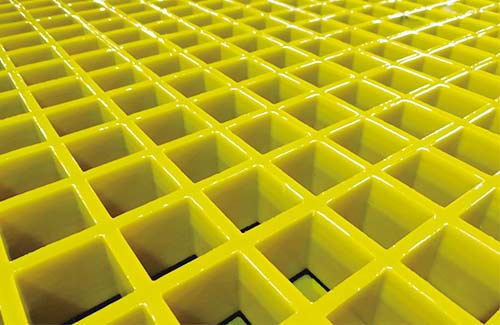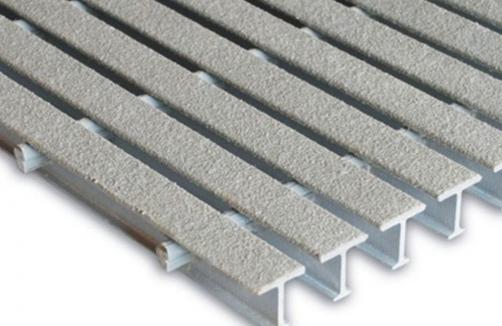Fiber Reinforced Polymer (FRP) grating has gained widespread adoption in various industries, including chemical processing, water treatment, power generation, and industrial manufacturing, due to its exceptional corrosion resistance, high strength-to-weight ratio, and low maintenance requirements. While FRP grating is inherently durable, its service life can be significantly extended through proper cleaning and maintenance practices. This article explores the key principles and methodologies for maintaining FRP grating through effective cleaning, ensuring optimal performance and longevity in harsh operational environments.
1. Understanding FRP Grating Material Properties
Before delving into cleaning protocols, it is essential to understand the composition and structural characteristics of FRP grating. FRP is a composite material consisting of polymer matrices (such as polyester, vinyl ester, or epoxy) reinforced with glass or carbon fibers. The surface texture of FRP grating typically features a gritted or molded surface for slip resistance, which can trap contaminants over time. Unlike metallic gratings, FRP does not rust, but it is susceptible to surface degradation caused by chemical exposure, UV radiation, and mechanical abrasion.
The polymer matrix in FRP grating is vulnerable to certain solvents and aggressive chemicals, while the fiber reinforcement provides structural strength. Surface contaminants, if left unaddressed, can create micro-environments that accelerate degradation. For example, accumulated dirt and debris can retain moisture, leading to prolonged exposure of the polymer to water, which may cause resin hydrolysis or fiber-matrix debonding in extreme cases. Understanding these material properties is crucial for developing cleaning strategies that protect both the surface and structural integrity of the grating.
2. Identifying Common Contaminants
FRP grating used in industrial settings is exposed to a variety of contaminants that necessitate regular cleaning. The nature of contaminants depends on the operational environment:
2.1 Inorganic Particles
Dust, sand, gravel, and metallic filings are common in manufacturing plants and construction sites. These particles can scratch the surface of the grating, creating pathways for moisture and chemicals to penetrate the resin matrix. Over time, repeated abrasion from loose particles can degrade the slip-resistant surface, compromising safety as well as structural integrity.
2.2 Organic Substances
Grease, oil, plant debris, and biological growth (such as algae and moss) are prevalent in outdoor installations or areas with poor ventilation. Organic contaminants not only create slippery surfaces but also act as food sources for microbial growth. Microbial colonies can produce acids that attack the polymer matrix, especially in warm and humid environments.
2.3 Chemical Residues
In chemical processing facilities, FRP grating may come into contact with acids, alkalis, solvents, or salt solutions. Even though FRP is highly resistant to many chemicals, prolonged exposure to incompatible substances can cause surface discoloration, swelling, or gradual erosion of the resin. Chemical residues can also act as catalysts for UV-induced degradation when exposed to sunlight.
2.4 Combustible Materials
In environments where fire safety is critical, such as refineries or power plants, accumulated dust, lint, or flammable residues on FRP grating can pose fire hazards. Regular cleaning is essential to mitigate these risks while maintaining the grating’s non-conductive and flame-resistant properties (depending on the resin type).
3. Developing a Cleaning Schedule
Consistency is key to preventing contaminant buildup and minimizing cleaning effort. The frequency of cleaning should be determined based on the severity of the operating environment:
3.1 Light-Duty Environments
In indoor settings with minimal contamination (e.g., commercial buildings or light industrial areas), a routine cleaning schedule of once every 1-3 months is usually sufficient. This involves removing loose debris and occasional wiping of surface stains.
3.2 Moderate-Duty Environments
Outdoor installations or facilities with moderate dust, grease, or chemical exposure require more frequent cleaning, typically every 2-4 weeks. In these environments, contaminants tend to accumulate faster due to weather conditions (rain, wind) and operational activities.
3.3 Heavy-Duty Environments
Industrial zones with high chemical exposure, heavy machinery, or harsh weather (such as coastal areas with salt spray or chemical plants with frequent spills) demand weekly or even daily cleaning. In such cases, proactive contamination control is necessary to prevent irreversible damage.
Before establishing a schedule, conduct a preliminary assessment of the grating’s condition and the nature of contaminants. Visual inspection, touch tests (for sticky residues), and pH testing (for chemical deposits) can help determine the appropriate cleaning frequency and methods.
4. Step-by-Step Cleaning Procedures
Effective cleaning of FRP grating involves a systematic approach that combines mechanical removal of debris with chemical treatment for stubborn stains, while avoiding damage to the material.
4.1 Pre-Cleaning Preparation
- Safety Precautions: Wear appropriate personal protective equipment (PPE), including gloves, goggles, and respiratory protection if using chemical cleaners. Ensure the area is well-ventilated, especially when working with volatile substances.
- Equipment Preparation: Gather cleaning tools such as soft-bristle brushes (nylon or polypropylene), pressure washers (with adjustable pressure), squeegees, buckets, and non-abrasive sponges. Avoid metal brushes or scouring pads, as they can scratch the surface.
- Surface Inspection: Identify areas with heavy contamination, surface damage, or loose debris. Note any discoloration or texture changes that may indicate chemical attack or UV degradation.
4.2 Dry Cleaning for Loose Debris
- Sweeping or Vacuuming: Start by removing dry particles using a stiff-bristle broom (for outdoor areas) or a vacuum cleaner (for indoor spaces). Pay special attention to the gaps between grating bars and the undersurface, where debris can accumulate. This step prevents abrasion during wet cleaning and ensures better contact between cleaning agents and the surface.
- Air Blowing: In hard-to-reach areas or when dealing with fine dust, use compressed air (at low pressure to avoid damaging the surface) to dislodge particles. This is particularly useful for elevated gratings or complex structures.
4.3 Wet Cleaning for General Soiling
- Rinsing with Water: Use a garden hose or pressure washer set to low pressure (typically below 1,500 PSI) to rinse the surface. High-pressure water can damage the resin matrix or dislodge the gritted surface texture. For vertical gratings or undersurfaces, direct the water flow at a 45-degree angle to enhance debris removal.
- Detergent Solution: Prepare a mild, pH-neutral detergent solution (avoiding solvents, abrasives, or harsh chemicals like bleach or strong alkalis). pH-neutral cleaners (pH 6-8) are safe for most FRP resins and effectively break down grease, oil, and organic stains. Apply the solution using a soft brush or sponge, gently scrubbing contaminated areas in a circular motion. Rinse thoroughly with clean water to remove all detergent residues, which can attract dirt if left on the surface.
4.4 Chemical Cleaning for Stubborn Stains
- Acid or Alkali Treatments: For specific chemical residues, use specialized cleaners compatible with FRP. For example, a mild acid solution (such as citric acid for mineral deposits) or a alkaline-based degreaser (for heavy oil stains) can be applied. Always test the cleaner on a small, inconspicuous area first to ensure no adverse reactions occur. Allow the cleaner to dwell on the stain for 5-10 minutes (as per manufacturer instructions) before scrubbing and rinsing.
- Solvent-Based Cleaners: In cases of adhesive residues or paint spills, use non-ionic solvents like isopropyl alcohol or acetone (in limited quantities). Ensure the solvent is compatible with the FRP resin—vinyl ester and epoxy resins generally have better solvent resistance than polyester. Avoid prolonged contact with solvents, as they may soften the resin.
4.5 Drying and Surface Inspection
- Drying Methods: Allow the grating to air dry naturally, or use squeegees to remove standing water, especially in low-lying areas where water can pool. Proper drying prevents the growth of mold and algae and reduces the risk of water-induced degradation.
- Post-Cleaning Inspection: Check for remaining stains or uneven cleaning. Repeat the cleaning process on stubborn areas, adjusting the cleaning method or agent as needed. Document the condition of the grating for future reference, helping to track degradation patterns over time.
5. Best Practices for Safe Cleaning
To avoid damaging FRP grating during cleaning, adhere to the following guidelines:
5.1 Avoid Harmful Cleaning Agents
- Harsh Chemicals: Never use hydrofluoric acid, concentrated sulfuric acid, or strong oxidizing agents, as they can dissolve the resin matrix or attack glass fibers. Chlorine-based bleach should also be avoided, as it may cause surface discoloration and weaken the polymer.
- Abrasive Materials: Steer clear of steel wool, metal scrapers, or coarse sandpaper, which can create micro-scratches that trap moisture and accelerate degradation. Even soft abrasives should be used sparingly and only on heavily soiled areas.
5.2 Control Mechanical Stress
- Pressure Washing Limits: As mentioned earlier, maintain low pressure when using power washers. Direct the nozzle at least 12 inches away from the surface to prevent localized impact damage. For gratings with delicate surface textures (e.g., gritted anti-slip surfaces), consider manual cleaning instead.
- Scrubbing Technique: Use gentle, consistent pressure when scrubbing, focusing on contaminated areas without overworking intact sections. Avoid repetitive scrubbing on the same spot, which can wear down the resin surface.
5.3 Environmental Considerations
- Drainage Management: Ensure that cleaning wastewater is properly contained and treated, especially in industrial settings where it may contain chemical residues. Improper drainage can lead to environmental contamination and may also expose the grating’s support structure to corrosive runoff.
- UV Protection During Cleaning: If the grating is exposed to sunlight, clean it during cooler times of the day (morning or evening) to prevent rapid evaporation of cleaning solutions, which can leave streaks or residue. Additionally, consider applying a UV-resistant topcoat during maintenance to enhance long-term weather resistance.
6. Integrating Cleaning with Comprehensive Maintenance
Proper cleaning is part of a broader maintenance strategy to maximize FRP grating lifespan:
6.1 Regular Inspections
Combine cleaning with visual inspections to identify early signs of damage, such as cracking, delamination, or fiber exposure. Inspect support structures (frames, clips) for looseness or corrosion, as misalignment can cause excessive stress on the grating panels.
6.2 Surface Protection
After cleaning, apply a protective coating if recommended by the manufacturer. Some FRP gratings may benefit from a clear polyurethane sealant or a gel coat to enhance UV resistance and facilitate easier future cleaning. Ensure the coating is compatible with the base resin to avoid adhesion issues.
6.3 Addressing Underlying Issues
If contaminants arise from operational processes (e.g., leaks, spills, or poor housekeeping), implement preventive measures such as installing drip pans, improving sealants, or enhancing workplace hygiene. Reducing the source of contamination is more effective than relying solely on reactive cleaning.
6.4 Thermal and Mechanical Stress Management
In environments with extreme temperature fluctuations or heavy loading, ensure the grating is properly supported and that thermal expansion gaps are maintained. Excessive stress can cause cracks that trap contaminants, making cleaning more difficult and accelerating degradation.
Conclusion
Proper cleaning is a vital component of maintaining FRP grating, directly influencing its service life, safety, and aesthetic appeal. By understanding the material’s properties, identifying contaminants, and implementing a structured cleaning schedule with appropriate techniques, industries can significantly extend the lifespan of their FRP grating systems. Remember that cleaning should always be part of a holistic maintenance approach, integrating inspection, protection, and preventive measures to address both surface contaminants and underlying operational factors. With consistent care, FRP grating can continue to deliver reliable performance in even the most challenging environments, offering a cost-effective and durable solution for industrial flooring and structural applications.
By following the guidelines outlined in this article, facility managers and maintenance teams can ensure that their FRP grating remains in optimal condition, reducing replacement costs and downtime while enhancing safety and operational efficiency. Regular, gentle cleaning combined with proactive maintenance is the key to unlocking the full lifespan potential of this versatile composite material.







